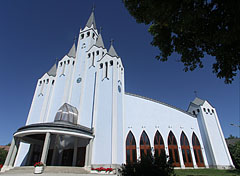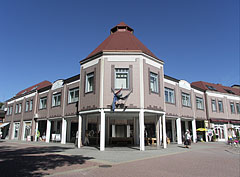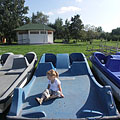(Optimized for small screen devices)
The town - Hévíz, Hungary
When you click:
Click on the pictures!
-

Roman Catholic Church of the Holy Spirit
Shooting date (date of photography): 17/07/20062006
Created by: Robert Németh
Camera model: Konica Minolta Dimage A200
Hévíz, Hungary
-

Shooting date (date of photography): 07/09/20082008
Created by: Robert Németh
Camera model: Konica Minolta Dimage A200
Hévíz, Hungary
-

Apartment houses
Shooting date (date of photography): 17/07/20062006
Created by: Robert Németh
Camera model: Konica Minolta Dimage A200
Hévíz, Hungary
-

High street of Hévíz with the Holy Spirit Roman Catholic church on the hill
Shooting date (date of photography): 17/07/20062006
Created by: Robert Németh
Camera model: Konica Minolta Dimage A200
Hévíz, Hungary
-

Another entrance of the lake bath at Kölcsey Ferenc Street
Shooting date (date of photography): 17/07/20062006
Created by: Robert Németh
Camera model: Konica Minolta Dimage A200
Hévíz, Hungary
-

Another entrance of the lake bath at Kölcsey Ferenc Street
Shooting date (date of photography): 17/07/20062006
Created by: Robert Németh
Camera model: Konica Minolta Dimage A200
Hévíz, Hungary
-

Newer arcaded buildings at Deák Ferenc Square
Shooting date (date of photography): 17/07/20062006
Created by: Robert Németh
Camera model: Konica Minolta Dimage A200
Hévíz, Hungary
-

Statue of Ferenc Deák Ferenc
Shooting date (date of photography): 17/07/20062006
Created by: Robert Németh
Camera model: Konica Minolta Dimage A200
Hévíz, Hungary
-

Café and Ice cream parlor
Shooting date (date of photography): 17/07/20062006
Created by: Robert Németh
Camera model: Konica Minolta Dimage A200
Hévíz, Hungary
-

Apartment house
Shooting date (date of photography): 17/07/20062006
Created by: Robert Németh
Camera model: Konica Minolta Dimage A200
Hévíz, Hungary
-
Restaurant on the main street, and farther the Holy Spirit Roman Catholic church
Shooting date (date of photography): 17/07/20062006
Created by: Robert Németh
Camera model: Konica Minolta Dimage A200
Hévíz, Hungary
Restaurant on the main street, and farther the Holy Spirit Roman Catholic church - Hévíz, Hungary -
Dr. Schulhof Vilmos promenade
Shooting date (date of photography): 17/07/20062006
Created by: Robert Németh
Camera model: Konica Minolta Dimage A200
Hévíz, Hungary
Dr. Schulhof Vilmos promenade - Hévíz, Hungary -
Dr. Schulhof Vilmos promenade
Shooting date (date of photography): 17/07/20062006
Created by: Robert Németh
Camera model: Konica Minolta Dimage A200
Hévíz, Hungary
Dr. Schulhof Vilmos promenade - Hévíz, Hungary -
Dr. Schulhof Vilmos promenade
Shooting date (date of photography): 17/07/20062006
Created by: Robert Németh
Camera model: Konica Minolta Dimage A200
Hévíz, Hungary
Dr. Schulhof Vilmos promenade - Hévíz, Hungary -
Creative advertisement of the Doll museum of Keszthely on the main street
Shooting date (date of photography): 17/07/20062006
Created by: Robert Németh
Camera model: Konica Minolta Dimage A200
Hévíz, Hungary
Creative advertisement of the Doll museum of Keszthely on the main street - Hévíz, Hungary -
"Stone"-shoe
Shooting date (date of photography): 17/07/20062006
Created by: Robert Németh
Camera model: Konica Minolta Dimage A200
Hévíz, Hungary
"Stone"-shoe - Hévíz, Hungary -
Saint Andrew's Rheumatology Hospital and Sanatorium (Szent András reumakórház) under the shady plane trees
Shooting date (date of photography): 17/07/20062006
Created by: Robert Németh
Camera model: Konica Minolta Dimage A200
Hévíz, Hungary
Saint Andrew's Rheumatology Hospital and Sanatorium (Szent András reumakórház) under the shady plane trees - Hévíz, Hungary -
Hotels
Shooting date (date of photography): 17/07/20062006
Created by: Robert Németh
Camera model: Konica Minolta Dimage A200
Hévíz, Hungary
Hotels - Hévíz, Hungary -
Snack bar
Shooting date (date of photography): 17/07/20062006
Created by: Robert Németh
Camera model: Konica Minolta Dimage A200
Hévíz, Hungary
Snack bar - Hévíz, Hungary -
Shooting date (date of photography): 17/07/20062006
Created by: Robert Németh
Camera model: Konica Minolta Dimage A200
Hévíz, Hungary
- Hévíz, Hungary -
Shooting date (date of photography): 17/07/20062006
Created by: Robert Németh
Camera model: Konica Minolta Dimage A200
Hévíz, Hungary
- Hévíz, Hungary -
Shooting date (date of photography): 17/07/20062006
Created by: Robert Németh
Camera model: Konica Minolta Dimage A200
Hévíz, Hungary
- Hévíz, Hungary -
Shooting date (date of photography): 17/07/20062006
Created by: Robert Németh
Camera model: Konica Minolta Dimage A200
Hévíz, Hungary
- Hévíz, Hungary -
Shooting date (date of photography): 17/07/20062006
Created by: Robert Németh
Camera model: Konica Minolta Dimage A200
Hévíz, Hungary
- Hévíz, Hungary -
Shooting date (date of photography): 17/07/20062006
Created by: Robert Németh
Camera model: Konica Minolta Dimage A200
Hévíz, Hungary
- Hévíz, Hungary -
Shooting date (date of photography): 17/07/20062006
Created by: Robert Németh
Camera model: Konica Minolta Dimage A200
Hévíz, Hungary
- Hévíz, Hungary -
Holy Spirit Roman Catholic church
Shooting date (date of photography): 07/09/20082008
Created by: Robert Németh
Camera model: Konica Minolta Dimage A200
Hévíz, Hungary
Holy Spirit Roman Catholic church - Hévíz, Hungary -
Shooting date (date of photography): 07/09/20082008
Created by: Robert Németh
Camera model: Konica Minolta Dimage A200
Hévíz, Hungary
- Hévíz, Hungary -
Shooting date (date of photography): 07/09/20082008
Created by: Robert Németh
Camera model: Konica Minolta Dimage A200
Hévíz, Hungary
- Hévíz, Hungary -
Shooting date (date of photography): 07/09/20082008
Created by: Robert Németh
Camera model: Konica Minolta Dimage A200
Hévíz, Hungary
- Hévíz, Hungary -
Shooting date (date of photography): 07/09/20082008
Created by: Robert Németh
Camera model: Konica Minolta Dimage A200
Hévíz, Hungary
- Hévíz, Hungary -
Shooting date (date of photography): 07/09/20082008
Created by: Robert Németh
Camera model: Konica Minolta Dimage A200
Hévíz, Hungary
- Hévíz, Hungary -
Shooting date (date of photography): 07/09/20082008
Created by: Robert Németh
Camera model: Konica Minolta Dimage A200
Hévíz, Hungary
- Hévíz, Hungary
Click on the pictures!
Characteristics, features, properties
Location:
GPS coordinates: Latitude 46°47'26", Longitude 17°11'7" (N46 47.43 - E17 11.12)
Information, short stories, interesting facts
 Roman Catholic Church of the Holy Spirit
Roman Catholic Church of the Holy Spirit
The pigeon motif generally applies to the modern style Church of the Holy Spirit of Hévíz, this bird refers to the common representation of the Holi Spirit. In addition, the floor plan of the Roman Catholic church also symbolizes a pigeon with opened wings.
 Dr. Schulhof Vilmos promenade
Dr. Schulhof Vilmos promenade
Dr. Vilmos Schulhof (or sometimes incorrectly Vilmos Schulhoff) was a rheumatologist and balneologists, a specialist who researches and applies the effects of medicinal thermal waters, he was born in Budapest, Hungary in 1974. He initiated the first sanatorium in Hévíz, which was finally built in 1907. In 1911 he estabilished his own Zander Therapeutic Institute in Hévíz, the third such institution in Europe after the one Strocholm, Sweden and the other one in Karlovy Vary (Carlsbad), Czech Republic. The institute used the so-called Zander Therapeutic Method, which was invented by the Swedish physician Dr. Gustav Zander (1835-1920) and based on mechanotherapy, medical gymnastic exercises carried out by means of a special apparatus. Dr. Vilmos Schulhof done so much to popularize Hévízfürdő ("Hévíz Baths" or "Thermal Baths") both in Hungary and abroad, but due to his Jewis origins from 1938 he wasn't allowed to publish anything. In 1944 he was deported from Hévíz to the ghetto of Keszthely, and soon he was died in the Auschwitz concentration camp.
 Dr. Schulhof Vilmos promenade
Dr. Schulhof Vilmos promenade
During the modernizations of the 1960s a new indoor bath was built on the Dr. Schulhof Vilmos Promanade in 1963. This is the so-called "Winter Spa", and thanks to this bathing in Hévíz isn't depend on the seasons any more. The nine thermal pools are waiting for the guests both summer and winter.
 Saint Andrew's Rheumatology Hospital and Sanatorium (Szent András reumakórház) under the shady plane trees
Saint Andrew's Rheumatology Hospital and Sanatorium (Szent András reumakórház) under the shady plane trees
After the miseries of the World War II which were followed by deprivatizations Hévízfürdő started to become important again. In 1952 by the initiative of the Ministry of Health (in Hungarian "Egészségügyi Minisztérium") there was opened the so-called State Spa Hospital of Hévíz ("Hévízi Állami Gyógyfürdőkórház") in the bathing resort, on the Dr. Schulhof Vilmos Promenade. The facility was further expanded in 1960, and after modernizations nowadays it is operating under the name of "Szent András Reumakórház" ("Saint Andrew Rheumatics Hospital"). It has an indoor bath within its area and provides many other services for those who wish to heal.
 Holy Spirit Roman Catholic church
Holy Spirit Roman Catholic church
The old Roman Catholic church was situated at the edge of the town and in spite of the many conversions it proved to be too small. The new modern church was designed by János Bocskai local architect, built during three years and opened in 1999. It has the capacity of more than thousand persons. Its seven towers (steeples) symbolize the seven gifts of the Holy Spirit (wisdom, understanding, counsel, knowledge, fortitude, piety, and fear of the Lord). The interior's floor plan is shaped like a hand-held fan or a sector of a circle, therefore the worshippers can sit as close as possible to the central place of the liturgy ceremonies.
Hévíz - More photo galleries:
You may also be interested in (Related pages):
Destinations, locations in the travel guide:
Hévíz (150 photos + 1 panoramic images)
Zala megye (county) (354 photos + 12 panoramic images)
Balaton Uplands National Park (Balaton-felvidék) (440 photos + 15 panoramic images)
Balaton (1,597 photos + 35 panoramic images)
Hungary (27,287 photos + 163 panoramic images)
and in addition:
(within here: Balaton Uplands National Park and Zala megye)
Balaton Uplands (Balaton-felvidék) (123 photos + 5 panoramic images)
Kis-Balaton
Kis-Balaton
Tihany (106 photos + 1 panoramic images)
Balatongyörök (8 photos)
Kehidakustány (31 photos)
Keszthely (100 photos + 8 panoramic images)
Zalakaros (43 photos + 3 panoramic images)
Keszthely (100 photos + 8 panoramic images)
Zalaegerszeg (22 photos)
Every panorama photo here:
Hévíz (1 photos)
Zala megye (county) (12 photos)
Balaton Uplands National Park (Balaton-felvidék) (15 photos)
Balaton (35 photos)
Hungary (163 photos)
Europe (165 photos)
Every regular photo here:
Hévíz (150 photos / 2 galleries)
Zala megye (county) (354 photos / 9 galleries)
Balaton Uplands National Park (Balaton-felvidék) (440 photos / 13 galleries)
Balaton (1,597 photos / 35 galleries)
Hungary (27,287 photos / 462 galleries)
Europe (30,494 photos / 523 galleries)
https://www.panadea.com/en/guidebook/heviz/photos/gal-002

Add to Favorites Add to Bookmarks
Share with your friends!
etc.
About us - Legal notice & Disclaimer -
All rights reserved
- ©2010-2022
Neuronit Creative Studio - Mogyoród / Budapest / Hungary





